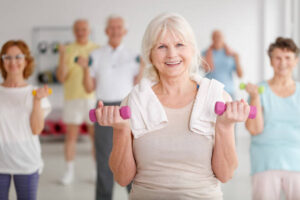Did you know the National Institute on Aging recommends that adults exercise at least three times per week? Regular exercise has been proven to help maintain functional independence, improve bone and joint health, support muscles, lower cardiovascular risk factors, and improve cognitive function. The many benefits of exercise are worth the effort you put in, no matter your age. With a movement regime in place, everyday tasks such as climbing stairs or lifting groceries become easier. The best exercises for aging adults involve a range of physical abilities and coordination while supporting stability and muscle conditioning.
Let’s explore different approaches to exercise that can be tailored to suit your individual needs.
- Yoga – Easily modified to suit many ranges of fitness or accommodate physical limitations, there are a range of options such as chair yoga, somatic yoga, standard practice, and restorative yoga. Each practice involves a series of poses that benefit balance, flexibility, posture, and strength. Yoga is incredibly beginning friendly
- Pilates – Similar to yoga, pilates doubles as a flexibility and stability exercise which improves balance, posture, and core strength. It also helps alleviate joint pain and gently build muscle, minimizing the risk of injury in the future. The defined movements practiced in pilates focus on alignment and technique. The movements can also be modified according to individual needs or limitations, which means this is an excellent choice for most people.
- Cycling – Cycling is another versatile option for those looking to get back into an exercise routine. Whether riding on the road or using a stationary bike, cycling will help develop leg and core strength. It is also an alternative for people with coordination limitations or those who are sensitive to joint impact.
- Swimming – Looking for a joint-friendly activity that allows you to move freely? Swimming or a water aerobics class may be the match for you. Swimming is a non-weight-bearing exercise, which means it does not place added pressure on the knees, hips, or spine. The water supports body weight making time in the water an effective method of alleviating joint strain and pain. This buoyancy allows for a more complete range of motion, keeping joints supple, while still working all major muscle groups. Swim exercises may vary from strength focuses (paddle board kicks and subtle resistance work) to mobility-specific strokes and laps around the pool.
- Walking – Don’t have a gym membership or any home equipment? No problem! A daily walk at a brisk pace is a simple, yet great way to get out and keep moving. This reliable movement option gradually builds your strength, improves circulation, and enhances cardiovascular strength. Challenge yourself by taking a steeper route or pick up the pace and time yourself. Since walking is a low-impact and equipment free activity, it can be modified for those who require a slower pace, mobility aid, or other limitations.
– – – – – – –
The material contained on this site is for informational purposes only and DOES NOT CONSTITUTE THE PROVIDING OF MEDICAL ADVICE, and is not intended to be a substitute for independent professional medical judgment, advice, diagnosis, or treatment. Always seek the advice of your physician or other qualified healthcare providers with any questions or concerns you may have regarding your health.
